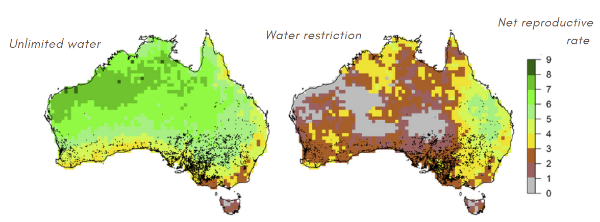Water, a limiting factor in lizard activities and distributionby Alice Loubet-Laouina
Published by the June 28, 2021 on 3:32 PM
Water is an increasingly scarce resource for us, so we can ask ourselves: When will it be for animals? How will they react: flee, adapt, evolve?
Predicting the effects of climate change on biodiversity is an ecological objective in conservation management. Here we are interested in water restriction role on activities and distribution on ectotherms with the mechanistic niche model.
Who am I

Photograph by Olivier Cardona, 2013My name is Tiliqua rugosa or Sleepy lizard.
I am an ectotherm. I explain: I don't produce heat, so I need the sun to warm me up.
I live in Australia.
I measure 40 to 45 mm.
I live for 50 years in the wild!
I love to eat flowers, fruits, and the leaves of annual plants.
I can lose more than 70% of my body water despite being adapted to the desert.
What is a mechanistic niche model?
So, the study scientists use this model with environmental and biological data of the Tiliqua rugosa. These data create Microclimate and Animal models. This allows us to understand how climate change affected species with a complex life cycle. This model makes it possible to make predictions on the distribution of animals. The same scientists used this method for another study (Enriquez-Urzelai et al. 2019).
Biological activities
When we talk about the biological cycle, we are talking about growth and reproduction activities. These activities require energy. Organisms have to make a trade-off between spending and storing energy.
The consequences of water restriction
When lizards only have access to water through their food or rainfall, their activities are reduced to the maximum to limit their dehydration and keep their energy. So Sleepy lizards hide in their burrows. They nest in a burrow up to 60 cm deep.
Water is a limiting factor in reproduction. According to two simulations, lizards reproduce little in the center and northeast of Australia.

Estimation of net reproductive rate
Climate change
To predict long-term evolution, we can use general circulation models in combination with mechanistic niche models. Therefore, it is interesting to compare different scenarios. Scenarios of the general circulation model1 can complement our niche model.
For the most part, water restriction is not a limiting factor for lizards. By running six scenarios under the assumption of water restriction, we find that the reproduction rate remains constant within the current ranges. The ACCESS 1.3 and GDFLCM3 Scenarios are exceptions.

Estimation of different scenarios
Species will be affected by climate change because it will depend on future precipitation patterns. Global warming could therefore cause increased dehydration regardless of rainfall variations.
1 General circulation model: statistics of several environmental factors allowing to make predictions according to different scenarios developed by countries.

This post is licensed under a Creative Commons Attribution-ShareAlike 4.0 International License.






